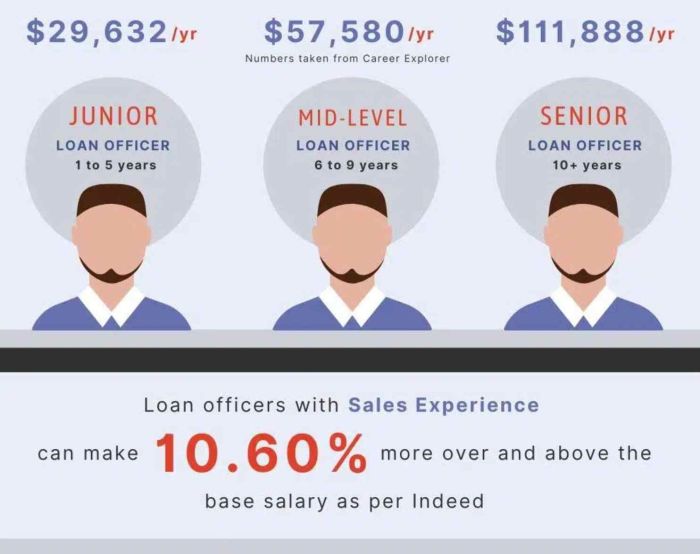Junior Loan Officer: Embark on a journey into the dynamic world of finance. This role, often a stepping stone to a successful career in lending, demands a unique blend of technical skills, interpersonal savvy, and unwavering dedication to regulatory compliance. From understanding intricate loan processing procedures to mastering client communication, a junior loan officer’s responsibilities are multifaceted and crucial to a financial institution’s success. This guide delves into the day-to-day realities, required skills, and career trajectory of this vital position.
We’ll explore the essential technical skills, such as proficiency in loan origination systems and financial analysis software, alongside the equally important soft skills, including effective communication and negotiation. We’ll also examine the regulatory landscape and risk management procedures that are paramount to this role. Understanding these elements is crucial for anyone considering or currently pursuing a career as a junior loan officer.
Required Skills and Knowledge

A successful junior loan officer requires a blend of technical proficiency, strong communication skills, and a solid understanding of financial principles. This role demands individuals who can analyze data, communicate effectively with clients and colleagues, and solve problems efficiently within a regulated environment. The following sections detail the essential skills and knowledge needed to excel in this position.
Technical Skills
Proficiency in relevant software is crucial for efficient workflow and accurate data management. Loan origination systems (LOS), customer relationship management (CRM) software, and spreadsheet programs like Microsoft Excel are essential tools. Familiarity with financial modeling software can also be beneficial for more complex loan applications. Advanced skills in data analysis tools like SQL could provide a significant advantage. A strong understanding of these technologies allows junior loan officers to process applications quickly, accurately assess risk, and maintain organized records.
Communication and Interpersonal Skills
Effective communication is paramount in this client-facing role. Junior loan officers must be able to clearly explain complex financial information to clients with varying levels of financial literacy. This requires strong verbal and written communication skills, active listening, and the ability to build rapport. Interpersonal skills are vital for collaborating with colleagues across different departments, including underwriters, closers, and management. The ability to negotiate and resolve conflicts constructively is also crucial for navigating the complexities of loan transactions.
Financial and Analytical Skills
A thorough understanding of financial principles is fundamental. Junior loan officers need to analyze financial statements, assess creditworthiness, understand loan terms and conditions, and calculate loan payments. Analytical skills are essential for interpreting data, identifying trends, and making informed decisions about loan applications. Strong mathematical skills are also important for accurately calculating interest rates, amortization schedules, and other financial metrics. These skills ensure responsible lending practices and minimize financial risk.
Problem-Solving Skills
Problem-solving is a critical skill in this role, as junior loan officers regularly encounter challenges throughout the loan process. For example, they might need to resolve discrepancies in application documentation, address client inquiries about loan terms, or navigate unexpected delays in the approval process. Effective problem-solving involves identifying the root cause of the problem, developing creative solutions, and implementing those solutions efficiently. This often requires collaboration with other team members and a willingness to adapt to changing circumstances.
| Skill Category | Specific Skill | Importance Level | Example Application |
|---|---|---|---|
| Technical Skills | Proficiency in Loan Origination System (LOS) | High | Efficiently processing loan applications and managing client data. |
| Technical Skills | Microsoft Excel proficiency | High | Analyzing financial statements, creating amortization schedules, and building financial models. |
| Communication & Interpersonal Skills | Active listening and clear communication | High | Effectively explaining loan terms to clients and addressing their concerns. |
| Communication & Interpersonal Skills | Collaboration and teamwork | High | Working effectively with underwriters, closers, and other team members to ensure smooth loan processing. |
| Financial & Analytical Skills | Credit analysis and risk assessment | High | Evaluating the creditworthiness of loan applicants and identifying potential risks. |
| Financial & Analytical Skills | Understanding of loan products and regulations | High | Ensuring compliance with all relevant lending regulations and providing accurate information to clients. |
| Problem-Solving Skills | Identifying and resolving discrepancies in loan applications | Medium | Addressing missing documentation or inconsistencies in client-provided information. |
| Problem-Solving Skills | Developing creative solutions to unexpected challenges | Medium | Finding alternative solutions when faced with delays or unforeseen circumstances during the loan process. |
Loan Processing Procedures

Loan processing is a critical function within any lending institution, requiring meticulous attention to detail and adherence to strict regulatory guidelines. A junior loan officer plays a vital role in this process, contributing to the smooth and efficient flow of loan applications from initial submission to final approval. Understanding the procedures involved and potential challenges is essential for success in this position.
The loan processing procedure typically involves a series of sequential steps, each requiring specific actions and documentation. The junior loan officer’s responsibilities vary depending on the stage of the process, but generally involve data entry, verification, and communication with borrowers and other stakeholders. Efficiency and accuracy are paramount at every stage to minimize delays and potential errors.
Steps in Loan Application Processing
The following Artikels the typical steps involved in processing a loan application, along with the junior loan officer’s role in each step. The exact steps and level of involvement may vary depending on the type of loan and the lending institution’s policies.
- Application Intake and Initial Review: The junior loan officer receives the loan application, reviews it for completeness, and verifies the applicant’s identity and basic information. This includes checking for missing documents or inconsistencies in the provided data.
- Data Entry and Verification: All relevant information from the application is entered into the lending institution’s system. The junior loan officer then verifies the accuracy of the entered data against the original application documents. This step is crucial to prevent errors that could lead to delays or loan denials.
- Credit and Background Checks: The junior loan officer initiates credit reports and background checks on the applicant. They review the results to assess the applicant’s creditworthiness and identify any potential red flags. This may involve communicating with external credit bureaus.
- Financial Document Review: The junior loan officer reviews supporting financial documents such as pay stubs, tax returns, and bank statements to verify the applicant’s income, assets, and liabilities. This step ensures the accuracy of the financial information provided in the application.
- Loan Underwriting: While not always directly involved in the underwriting process itself, the junior loan officer prepares the necessary documentation for the underwriter, ensuring all required information is readily available. They may also assist in answering any queries from the underwriter.
- Loan Approval and Closing: Once the loan is approved, the junior loan officer helps prepare the closing documents and communicates the approval details to the applicant. They may also be involved in scheduling the closing meeting.
Common Challenges in Loan Processing
Several challenges can arise during the loan processing procedure. Effective handling of these challenges is crucial for maintaining efficiency and minimizing delays.
- Incomplete or Inaccurate Applications: Missing information or discrepancies in the application can significantly delay the process. The junior loan officer must effectively communicate with the applicant to obtain the necessary information or corrections.
- Discrepancies in Financial Documents: Inconsistencies between the applicant’s stated income and the supporting financial documents can raise red flags. The junior loan officer needs to thoroughly investigate these discrepancies and clarify any inconsistencies with the applicant.
- Credit Report Issues: Negative items on the applicant’s credit report, such as bankruptcies or late payments, can impact loan approval. The junior loan officer needs to carefully review these items and assess their impact on the loan application.
- System Errors and Technical Issues: Technical glitches or errors within the lending institution’s system can cause delays. The junior loan officer should be adept at troubleshooting minor technical issues and escalating major problems to the appropriate IT support.
Handling Errors and Discrepancies
Addressing errors and discrepancies promptly and efficiently is critical to a smooth loan processing procedure. This involves a systematic approach to verification and communication.
When errors or discrepancies are identified, the junior loan officer should first carefully review the application and supporting documents to verify the nature and extent of the problem. They should then communicate clearly and professionally with the applicant to obtain clarification or necessary corrections. Proper documentation of all communication and actions taken is essential. In cases where the discrepancy cannot be resolved, the junior loan officer should escalate the issue to a senior loan officer or underwriter for further review and decision-making.
Loan Processing Flowchart
A visual representation of the loan processing procedure can be helpful. The following describes a flowchart, starting with the loan application and ending with loan approval. The flowchart would show a series of boxes and arrows, illustrating the sequential steps. Each box would represent a stage in the process (e.g., Application Intake, Data Entry, Credit Check, Underwriting Review, Loan Approval). Arrows would indicate the flow from one stage to the next. Decision points, such as whether the application is complete or if further information is required, would be represented by diamonds. The final box would indicate Loan Approval or Denial.
Regulatory Compliance and Risk Management: Junior Loan Officer

Adherence to lending regulations is paramount for junior loan officers. Failure to comply can result in severe consequences for both the individual and the lending institution. This section Artikels the importance of regulatory compliance, risk mitigation strategies, common compliance issues, and the potential repercussions of non-compliance. Understanding these aspects is crucial for responsible and ethical loan processing.
Importance of Adhering to Lending Regulations
Lending regulations are designed to protect consumers and maintain the stability of the financial system. These regulations cover various aspects of the lending process, including eligibility criteria, loan terms, disclosures, and reporting requirements. Compliance ensures fair lending practices, prevents discrimination, and protects borrowers from predatory lending. By adhering to these regulations, junior loan officers contribute to a fair and transparent lending environment, safeguarding the reputation of their institution and minimizing legal and financial risks.
Procedures for Identifying and Mitigating Potential Risks
Identifying and mitigating potential risks is a continuous process that requires vigilance and attention to detail. This involves regularly reviewing loan applications for inconsistencies, verifying borrower information, and assessing the creditworthiness of applicants. Risk mitigation strategies include implementing robust underwriting procedures, employing appropriate risk scoring models, and maintaining thorough documentation. Regular training and updates on compliance requirements are essential for junior loan officers to effectively identify and manage potential risks. For example, a thorough review of a borrower’s income verification documentation can mitigate the risk of inaccurate income reporting, which could lead to loan default.
Examples of Common Compliance Issues in Loan Processing
Common compliance issues in loan processing include inaccurate or incomplete documentation, failure to properly disclose loan terms, discrimination in lending practices, and inadequate risk assessment. For example, failing to properly disclose the Annual Percentage Rate (APR) or other loan fees can lead to regulatory penalties. Similarly, using biased criteria in assessing loan applications, such as age or race, constitutes discrimination and is a serious compliance violation. Inadequate risk assessment, such as overlooking a borrower’s high debt-to-income ratio, can increase the risk of loan default.
Consequences of Non-Compliance
The consequences of non-compliance with lending regulations can be severe. These can include substantial fines, legal penalties, reputational damage, and even criminal charges. For example, a lending institution found guilty of discriminatory lending practices may face significant financial penalties and legal action. Moreover, non-compliance can erode public trust and damage the institution’s reputation, leading to a loss of business. For junior loan officers, non-compliance can result in disciplinary action, including termination of employment.
Key Regulations Relevant to Junior Loan Officers
Understanding relevant regulations is critical. These regulations often change, necessitating ongoing professional development. Here are some key areas:
- The Equal Credit Opportunity Act (ECOA): Prohibits discrimination in lending based on race, color, religion, national origin, sex, marital status, age, or the receipt of public assistance.
- The Truth in Lending Act (TILA): Requires lenders to disclose all loan terms and conditions clearly and conspicuously to borrowers.
- The Real Estate Settlement Procedures Act (RESPA): Regulates real estate settlement services and requires lenders to provide borrowers with specific disclosures.
- The Fair Housing Act: Prohibits discrimination in housing-related lending based on race, color, national origin, religion, sex, familial status, or disability.
- The Fair Debt Collection Practices Act (FDCPA): While not directly related to loan origination, it’s crucial for handling defaulted accounts and interacting with borrowers experiencing financial difficulties.
Customer Interaction and Communication
Effective communication is paramount for junior loan officers. Building strong relationships with clients is crucial for securing loans and maintaining a positive reputation for the lending institution. This involves employing various strategies to understand client needs, manage expectations, and resolve conflicts professionally.
Effective communication strategies involve active listening, clear and concise language, and empathy. Understanding the client’s financial situation and goals is vital to tailoring the loan process to their specific needs. This involves asking clarifying questions, summarizing key points to ensure understanding, and providing straightforward explanations of complex financial terms. Regular communication, including updates on loan progress and addressing any concerns promptly, fosters trust and transparency.
Active Listening and Empathetic Responses, Junior loan officer
Active listening goes beyond simply hearing what a client says; it involves understanding their perspective and emotions. This includes maintaining eye contact, nodding to show engagement, and asking clarifying questions to ensure complete understanding. Empathetic responses, such as acknowledging the client’s concerns and validating their feelings, build rapport and demonstrate care. For example, if a client expresses anxiety about the loan application process, a response like, “I understand this can be a stressful time, and I’m here to guide you through each step,” can alleviate their concerns and build trust.
Handling Difficult Client Situations
Difficult situations may arise, such as dealing with irate clients or managing disagreements. Maintaining composure, remaining professional, and actively listening to the client’s concerns are essential. Finding common ground and collaboratively seeking solutions are key to de-escalating tense situations. If a disagreement arises, documenting the conversation and following established protocols for conflict resolution is crucial. For instance, if a client is upset about a delay in the loan process, a calm and reassuring response, such as, “I understand your frustration, and I apologize for the delay. Let’s review the timeline together and find a solution,” can help to diffuse the situation.
Examples of Professional Communication
Professional communication involves using clear and concise language, avoiding jargon, and maintaining a respectful tone. Emails should be well-structured, with a clear subject line and a professional closing. Phone conversations should be conducted in a polite and courteous manner, with active listening and clear articulation. For example, an email confirming loan application receipt should include the application number, a brief summary of the next steps, and a contact person for any questions. A phone conversation with a client should start with a polite greeting, a brief introduction, and a clear explanation of the purpose of the call.
Building Rapport and Trust
Building rapport involves establishing a positive relationship with clients based on mutual respect and understanding. This is achieved through active listening, empathy, and demonstrating genuine interest in their needs. Trust is built through transparency, honesty, and consistently meeting expectations. For instance, proactively providing updates on loan progress, promptly responding to inquiries, and being accessible to answer questions builds trust and confidence. Providing clear and accurate information, even if it’s not what the client wants to hear, demonstrates integrity.
Managing Client Expectations
Managing client expectations involves setting realistic timelines and clearly communicating the loan process. This includes providing regular updates on progress, addressing concerns promptly, and managing any potential delays proactively. For instance, if a delay is anticipated, informing the client well in advance and explaining the reasons for the delay can prevent misunderstandings and maintain a positive relationship. Setting clear expectations from the outset about the required documentation, the timeline, and the communication frequency ensures a smoother and more positive experience for both the client and the loan officer.
Technology and Tools Used
Junior loan officers rely heavily on various technologies to streamline the loan process, ensuring accuracy, efficiency, and regulatory compliance. These tools range from loan origination systems (LOS) to customer relationship management (CRM) software and specialized analytical platforms. Proficiency in these technologies is crucial for success in this role.
The effective utilization of technology significantly impacts a junior loan officer’s productivity and the overall quality of loan processing. This section will detail the common software and technologies employed, their functions, and how they contribute to a more efficient workflow.
Loan Origination Systems (LOS)
Loan origination systems are the backbone of the loan process, automating many tasks from application intake to closing. Different LOS platforms offer varying features and functionalities, impacting the efficiency and overall experience. For example, some systems may excel in automated underwriting, while others might prioritize robust reporting and analytics. Understanding the strengths and weaknesses of different LOS platforms is essential for a junior loan officer.
Customer Relationship Management (CRM) Software
CRM software plays a vital role in managing interactions with borrowers and other stakeholders throughout the loan lifecycle. These systems allow loan officers to track communication, manage documents, and maintain a comprehensive record of each borrower’s journey. Features such as automated email sequences and integrated communication tools enhance efficiency and improve customer service. Examples of commonly used CRM systems include Salesforce and HubSpot, though many specialized platforms exist within the financial services sector.
Document Management Systems
Efficient document management is critical in loan processing, given the volume of paperwork involved. Dedicated document management systems allow for secure storage, easy retrieval, and collaborative access to loan-related documents. These systems often integrate with LOS and CRM platforms, creating a centralized repository for all loan-related information. This integration reduces the risk of errors and delays caused by misplaced or lost documents.
Underwriting and Credit Scoring Software
Underwriting software automates the risk assessment process, analyzing borrower information to determine creditworthiness. These systems utilize sophisticated algorithms and credit scoring models to generate risk scores and recommendations, significantly reducing the manual effort required for credit analysis. Examples include systems that integrate with credit bureaus to access real-time credit reports and perform automated checks against fraud databases.
Financial Modeling and Analysis Tools
Junior loan officers often utilize financial modeling and analysis tools to assess the financial viability of loan applications. These tools may include spreadsheets (like Microsoft Excel) or specialized financial modeling software. They are used to create projections, analyze cash flows, and assess the overall financial health of borrowers. Accurate financial modeling is crucial for making informed lending decisions and mitigating risk.
Technology Interaction Diagram
Imagine a central hub representing the loan application. From this hub, lines extend to represent the interaction with different technologies. A line connects to the LOS, which then branches out to connect with the underwriting software, the document management system, and the CRM. The CRM connects to communication tools, such as email and phone systems. The underwriting software connects to credit scoring services and fraud detection databases. Finally, a line from the hub connects to financial modeling tools, allowing for analysis of borrower financial information. This illustrates the interconnected nature of these technologies in supporting the entire loan process.
Salary and Benefits

Compensation for junior loan officers varies significantly based on several key factors, including location, experience, employer size, and the specific financial institution. Understanding the typical salary range and benefits packages is crucial for prospective and current junior loan officers alike. This section provides a detailed overview of these aspects, offering insights into compensation structures across different financial institutions.
Typical Salary Ranges for Junior Loan Officers
Salaries for junior loan officers are influenced by geographical location, with major financial centers typically offering higher compensation. Cost of living significantly impacts these variations. For example, a junior loan officer in New York City might earn considerably more than one in a smaller city like Omaha, Nebraska. Furthermore, experience, even within the junior level, plays a role; someone with a year of experience will likely command a higher salary than a recent graduate.
Common Benefits Packages for Junior Loan Officers
Most financial institutions offer comprehensive benefits packages to attract and retain talent. These commonly include health insurance (medical, dental, and vision), paid time off (vacation, sick leave), retirement plans (401k with employer matching), life insurance, and disability insurance. Some institutions may also offer additional perks such as tuition reimbursement, professional development opportunities, employee assistance programs (EAPs), and employee stock options. The comprehensiveness of these benefits varies considerably depending on the employer’s size and financial stability.
Comparison of Compensation Packages Across Different Financial Institutions
Compensation packages differ substantially across various financial institutions. Large multinational banks often offer higher base salaries and more comprehensive benefits packages compared to smaller regional banks or credit unions. However, smaller institutions might offer a more collaborative work environment or quicker advancement opportunities that could offset a lower initial salary. Similarly, specialized finance firms focusing on niche markets might offer compensation structures aligned with their specific industry demands and profitability. For instance, a firm specializing in commercial real estate lending might offer higher compensation packages reflective of the expertise and risk involved in those transactions.
Factors Influencing Salary and Benefits
Several factors significantly impact a junior loan officer’s salary and benefits. These include:
| Location | Average Salary | Common Benefits | Factors Affecting Compensation |
|---|---|---|---|
| New York City, NY | $60,000 – $80,000 | Health insurance, 401k, paid time off, life insurance, disability insurance | High cost of living, competitive job market, experience level |
| Chicago, IL | $55,000 – $75,000 | Health insurance, 401k, paid time off, life insurance, disability insurance, potential for bonuses | Moderate cost of living, established financial sector |
| Omaha, NE | $45,000 – $65,000 | Health insurance, 401k, paid time off, life insurance | Lower cost of living, less competitive job market |
| San Francisco, CA | $70,000 – $90,000 | Comprehensive benefits package including health insurance, 401k, paid time off, life insurance, disability insurance, potential for stock options | Extremely high cost of living, strong tech and finance presence |
Note: Salary ranges are estimates and can vary based on individual experience, education, and performance. Benefits packages are also subject to change.
Last Recap

Becoming a successful junior loan officer requires a potent combination of technical expertise, strong interpersonal skills, and a meticulous approach to regulatory compliance. This guide has provided a foundational understanding of the role’s multifaceted demands, highlighting the path to career progression and the essential skills needed to thrive. By mastering loan processing, client communication, and risk management, aspiring junior loan officers can confidently navigate the complexities of the financial world and build a rewarding career.
Detailed FAQs
What is the typical starting salary for a junior loan officer?
Starting salaries vary significantly based on location, experience, and the employing institution. Researching salary ranges in your specific area is recommended.
What is the potential for advancement in this career?
Career progression can lead to senior loan officer roles, loan management positions, or even into specialized areas like commercial lending or mortgage lending.
What are the common challenges faced by junior loan officers?
Challenges include managing high-pressure situations, handling difficult clients, meeting tight deadlines, and staying abreast of ever-changing regulations.
How important is networking in this field?
Networking is crucial for career advancement and gaining insights into industry trends. Attending industry events and building relationships with colleagues is highly beneficial.






